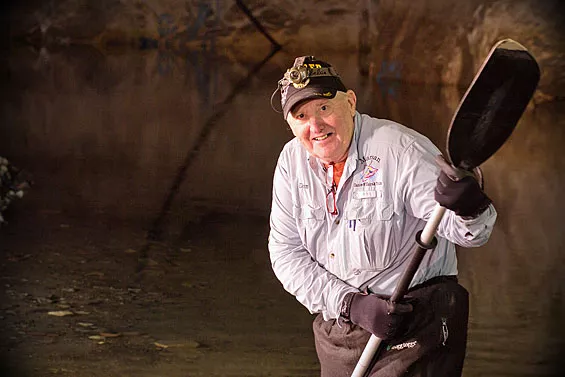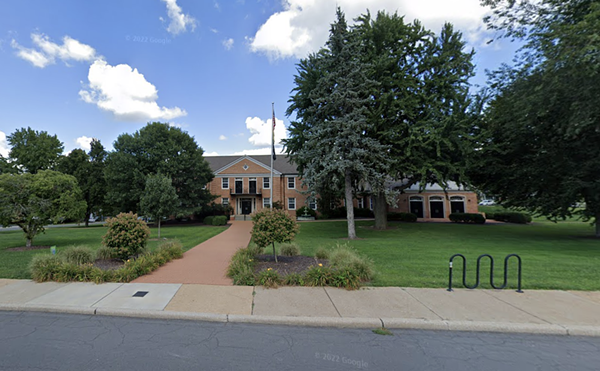Hardly anything stirs the silence deep within the Crystal City sand mine, a 6-million-square-foot cavern carved into a Mississippi River bluff about 30 miles south of St. Louis.
For more than a century workers toiled inside the mine's massive caverns, excavating silica and sand for the nearby Pittsburgh Plate Glass factory. But the last of the PPG laborers packed up their drills and dynamite in the 1980s. Gone, too, is the power to pump out the encroaching waters of an aquifer located somewhere even deeper in the earth. Today much of the mine lies drowned beneath a still and glasslike lake that spans some 150 acres.
Into this eerie stillness enters Don Marsan, a gruff and seasoned spelunker who has made it his mission to explore by kayak the dark vastness of this aquatic underworld and share it with others.
"Ain't this fuckin' place amazing?" Marsan asks (for what feels like the hundredth time) while giving a recent tour to some fellow kayakers. A military veteran and former firefighter, the 66-year-old Marsan gives off the impression of a rough but kindly handyman while his New England accent makes him sound remarkably like West Wing-era Martin Sheen.
PHOTOS: Crystal City Underground Kayak Tour
Sparsely shaven and sporting a light gray jacket, waders and boots, Marsan plies his way through the vertigo-inducing darkness with no map. For a long while, the splish-splosh of the kayak paddles is the only sound inside vacuumlike blackness. Marsan keeps his headlamp switched off as much as possible, preferring instead to use the lamps attached to the bottom of his kayak and the powerful beam of a 275-lumen, handheld spotlight. About 30 feet underwater, these lights reveal submerged tire tracks, dislodged pipelines and unidentifiable machinery.
"All right, we're going to stop here," Marsan tells the group after paddling nearly two hours. The lights from the stopped kayaks throw green wave patterns onto the cavern walls like some kind of underground aurora borealis. Gently, Marsan slides his paddle inside his kayak.
"This is the squeeze tube," he says, introducing this area at the eastern edge of the flooded mine. "The next column is where we're going really low, and you're going to have to remove your headlamp."
Here, only two feet of air separates the water surface from the ceiling. It feels as though the cave is flattening itself, crushing reality into a thin, breathable sliver.
"To lay down in the boat, all you do is slide down like this." Marsan places both hands on either side of his kayak and scoots his legs forward until he's fully horizontal. He waves a hand about a foot above his face. "The ceiling is going to be right here. This is where you're going to have to tilt your head sideways."
There's no room to use a paddle in the squeeze tube, and Marsan shouts a few tips about hand placement on the ceiling as he guides his kayak through the remaining air.
As he vanishes beneath the ceiling, his voice calls out from somewhere in the void.
"Now right here are the titties," laughs the voice in describing two handholds where a kayaker can just slide through. Using his cackling as guidance, the fellow kayakers place their hands on the ceiling and push their boats along until the mine's roof again rises. Minutes later, the kayakers are in a large passageway with a 30-foot ceiling.
For a year and a half now, Marsan has been leading kayak tours in this old mine, exploring its strange nooks and forgotten secrets with his own brand of tour-guide exuberance. By his count, he has taken more than 1,200 people out on the water. And while the mine's eccentric owner has converted parts of the cave to other uses — sand volleyball courts, Frisbee golf links, a nightclub — the lake is Marsan's refuge and a proving ground for both himself and others.
At the end of this day's tour, after numerous turns and pit stops, Marsan wraps up the way he usually does. He picks out a participant.
"OK," Marsan tells him. "Take us home."
It's a daunting proposition, almost cruel. Without a sense of bearings, the powerful lanterns are barely useful. Each passing corridor appears to stretch infinitely into a common darkness.
"I'm following you," Marsan says simply, letting his kayak drift behind the group. "Lead the way."






